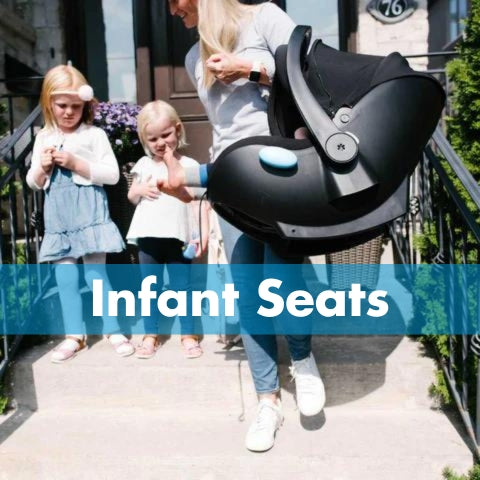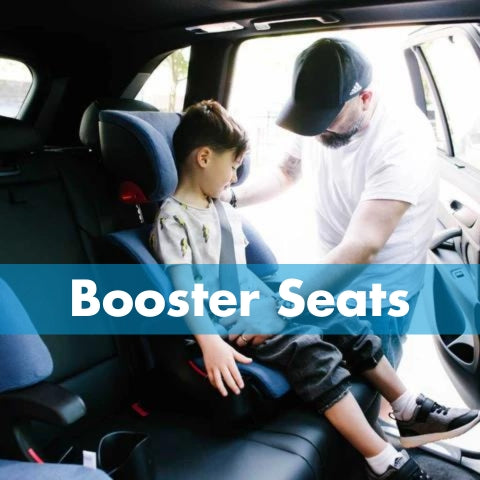Have you walked into the car seat section of a store recently? Overwhelming eh? Today there are hundreds of car seats on the market to choose from and it often leaves parents feeling confused and unsure how to pick the right one. Where and how to do even begin to narrow down the field? We’ve got some info to help you make that decision confidently.
What are the different types of seats?
Rear-facing only seat (aka infant seat, bucket)
Age range: Newborn – 18 months

These are the seats that most parents choose to use when their child is first born. They offer the convenience of a carry handle, you can buy multiple bases for the different cars baby will be in, and you can move the car seat easily from your car to a stroller! Keep in mind that rear-facing only seats are designed to ONLY be installed rear-facing. These seats are usually outgrown within the baby’s first year. But by around 9 months the weight of the seat and the baby combined becomes too much for a lot of parents to handle.
Convertible seat
Age range: Newborn – 6 years

These seats can be installed both rear and forward-facing. Some have limits low enough to accommodate a newborn baby, so if you are looking to skip the rear-facing only seat all together because of its limited use, you certainly have options! But, typically the convertible seat is the second seat you will purchase once your child outgrows their “bucket”. They will remain rear-facing in their convertible until at least age two. Once outgrown in rear-facing mode the convertible can then be installed forward-facing for the child to continue using even longer. TaDa! Some convertible seats can last children until they are ready to move on to the next stage of seats, boosters. The average child can spend anywhere from 4-6 years in their convertible seat, so this is a stage that you will want to do your homework on and be sure you get the seat that best fits your needs (more on that later down this post).
Booster seat
Age range: 4+ - 5 Step Test

This is the last stop on the car seat train. The job of a booster is to simply lift the child up so that the adult seat belt fits them properly. There are high back boosters and backless boosters. The biggest advantage to a high back booster is that it provides head support for the child as well as a guide for the shoulder belt to ensure it also rests properly across their body. Some high back boosters may also have a recline adjustment available. Having a slight recline with a booster seat can be beneficial for kids who often sleep in the vehicle as it helps keep them upright if they fall asleep. Not sure if your child is ready for this stage? Check out our article to help you make that decision.
Now, there are a couple other types of car seats out there that don’t fit into the above categories, but if you shop wisely between the three main categories, chances are you’ll never need these. A combination seat is a forward-facing harness seat that can be converted to a booster. Some combination seats have higher limits for harnessing and work well for children who are not ready to transition to a booster but have outgrown their convertible. These often work well for special needs situations. 3-n-1 car seats can be used rear-facing, forward-facing, and be converted into a booster. While this sounds like a no-brainer, proceed with caution! It is no easy feat to pack three different seats into one, and sometimes you will find that one area falls short with these seats.
I now know the type of seat my child needs, but there are still a lot of options. How do I pick the RIGHT one?
There is no one right seat for everyone. Kids, parents, and cars come in all different shapes and sizes. This is one of the reasons there ARE soo many options when it comes to car seats. So what is the best seat for you?
The best car seat is the one that:
- Fits your child – Choose a seat that fits your child now and will fit them for a while. When shopping pay close attention to the height and weight limits. For harnessed seats, set your child in the seat and see how far they have to grow before reaching the top harness position. For high back booster seats set your child in the seat with the headrest raised to the highest position so that you can see how long it will last them.
-
Fits your vehicle – If possible, try a car seat in your vehicle before purchasing. Not all car seats will work with all vehicles. Seats that rear-face will take up the most room in your back seat, so you want to ensure that the car seat will not impact the front passenger’s room.
- Good to know: A driver should always have at least 10 inches of space between the center of their breastbone and the steering wheel. If this cannot be accomplished with a rear-facing seat behind the driver consider moving the car seat to a different seating position.
- Will be installed and used properly every ride – This is also referred to as ease of use. You need to be comfortable and confident in your abilities to install the car seat you purchase. The adorable pattern on a seat is not going to keep your child safe in a collision, the proper installation will. Browse thru the manual, try and install a display seat in your vehicle if your retailer allows, look up the manufacturer’s website to see what support they offer online. The more support there is available to you, the more successful you will be at being the 1 out of 4 people who have it done correctly! You will also want to make sure it is easy to strap your child in. For harnessed seats check to see if you can easily access the harness adjuster. Loosen and tighten the harness. Adjust the headrest. These are all things you will need to do to keep your child safe and secure in their new seat.
Once you’ve followed these steps you should find yourself with a short list of finalists to choose from. Now is the time to check out those cover options and select the one that makes your heart skip a beat!




